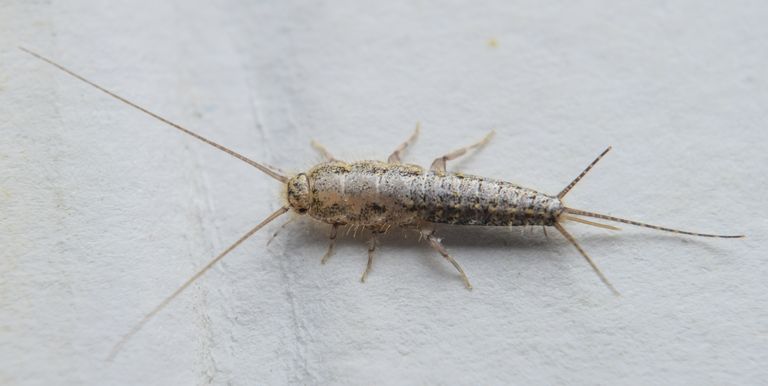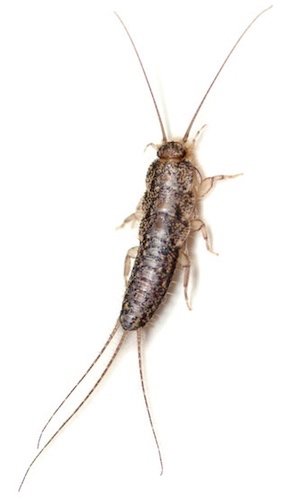Ways to Get Rid of Silverfish
Of all the insect infestations you can be cursed with, silverfish might just be the most skin-crawling — right after cockroaches, of course. Silverfish are mostly a (super-creepy) nuisance pest, but they can destroy books, wallpaper, and clothes with their excrement, according to the experts at Penn State’s Department of Entomology Cooperative Extension program. If you find silverfish in your home, you definitely want them gone fast, but pesticides aren’t the only way to go.
Seal Up Food
You don’t want to pour out a bowl of your favorite cereal just to find it’s swimming with these squirming insects. Penn State recommends sealing dry goods like cereal, pasta, rice, quinoa, flour, sugar, and pet food in sturdy, airtight containers to prevent silverfish from reaching these tempting food sources.
Reduce Humidity
Silverfish thrive in moist, humid environments, says James Norton of Fantastic Pest Control in London. Take away their favorite conditions by using a dehumidifier in damp basements, sealing up leaky pipes, and making sure the bathroom is well ventilated. You should also keep the weather out by sealing up exterior cracks with caulk and making sure gutters and downspouts are clear so water can run down and away, according to Penn State.
Clear Clutter
Silverfish also love hiding in — and feasting upon — old papers, magazines, and books, so if you tend to save every piece of paper that crosses your desk, you might need to do some clearing out. Get rid of the stuff you haven’t looked at in forever, and store items you can’t bear to part with in airtight bins, especially if the papers are kept in the basement or attic.
Sprinkle Diatomaceous Earth
Diatomaceous Earth, or DE, is a white crumbly powder consisting of the fossilized remains of diatoms, a class of algae. When silverfish come in contact with DE, it destroyers their outer waxy coating, causing them to lose moisture and die. You can sprinkle it around the baseboards in your home, and other places you’ve seen silverfish.

How to Get Rid of Silverfish
Silverfish are fairly harmless, but these grayish-blue, serpentine creatures aren’t pleasant to have around the house. They feed on books, dead skin cells, and other starchy materials and thrive in dark, wet spaces. Once you’ve determined you have an infestation, you can get rid of silverfish by trapping them, repelling them, killing them with insecticides, or making your home less hospitable. There are plenty of options to try, so be aware that you may have to experiment and implement several techniques to completely fix your silverfish problem.
Trapping Silverfish
Figure out where they’re lurking. Since silverfish are nocturnal, you may not see them during the day. Rather, you’ll probably become aware of their presence because of what they leave behind. Look for damp, dark areas with small spots of excrement that look like black pepper. Small holes and yellowish stains on clothing, wallpaper, cereal boxes, and other cardboard or fabric materials also indicate they’re nearby. Finally, silverfish shed their skin, so you can look around for tiny skin casts in your bathroom, basement and other areas where you suspect they live
Set out homemade glass silverfish traps. Take a quart-sized mason jar or another glass container. Wrap the outside of the container with a piece of masking tape. Place a piece of bread at the bottom of the glass. Set the glass in an area where you suspect silverfish reside. Make sure to wrap tape all the way to the top. The silverfish will climb into the glass to eat the bread, but they’ll be unable to get back out, since the glass is too slippery.
Try newspaper traps. Roll up a newspaper, band the ends with elastic, and moisten it. Set it out where you often see silverfish leavings before you go to bed. In the morning, silverfish will have eaten their way into the newspaper, since you’ve provided them with both food and a cozy environment
Use store-bought traps. If you don’t want silverfish touching your glassware, you can buy traps designed to catch them from a hardware store. Any type of sticky traps will work. Buy some “roach motels” or smaller traps you can set around to catch the silverfish. You can bait them with small pieces of bread or another starch.

Repel and Prevent Silverfish in Your
Why they like it in your home
Plenty to eat. They tend to eat sugary substances called polysaccharides that are found in numerous household objects, such as book glue, carpet fibers, household glue, paint, fabrics, and even your furniture.
Places to hide. They leave their eggs, which look like white and yellow bulbs, in dark, moist, hidden areas of your home.
Moisture. Like many other household pests, they thrive in moist, humid environments.
Places to thrive. They can live up to 8 years and reproduce frequently throughout their lives. This is why they can be a huge nuisance and over time they can cause damage to household items.
Here are some tips for getting rid of silverfish, both with at-home ingredients and special tools available at many home improvement stores.
Put a starchy food or substance in a glass container and wrap the outside with tape. This way, silverfish can get into the jar by climbing up the textured surface of the tape, but they won’t be able to get back out because their feet can’t adhere to the smooth glass surface inside.
Roll up newspaper. Wet it so silverfish crawl into it and make their homes. After a few days, throw the newspaper away or burn it to get rid of the silverfish that have stayed in there.
Put out sticky traps. Silverfish can crawl and get stuck on these.
Put out small bits of silverfish poison. Don’t use this method if you have pets or children who might eat or touch the poison.
Use cedar or cedar oil. You can use the oil in a diffuser or a spray bottle filled with water and cedar oil. They hate the strong-smelling pheromones in cedar.
Spread dried bay leaves throughout your home. Silverfish and other insects are repelled by its oils.
Here are some tips to keep silverfish from becoming a problem in your home:
Keep all dry food in your cupboards in sealed containers. This will keep them free of moisture.
Dust your home often. This will keep silverfish from particles that may contain starches or saccharides that they like to eat.
Remove items with adhesive from your home. This includes stacksof paper, laundry, cardboard boxes, or other items that silverfish could be attracted to.
Store clothes in a dry environment. Store clothes you won’t wear for a while in containers that silverfish can’t get into.
Clean up any food particles around your home. This is especially important right after a meal. Use a HEPA vacuum that can also suck up silverfish eggs and keep them from reproducing and multiplying.
Use caulking. Cover up cracks, holes, or openings to keep silverfish out and stop them from laying eggs.
Get a dehumidifier. Live in a moist climate? Reduce the humidity in your indoor air to 60 percent or lowerTrusted Source to stop silverfish from living and thriving in your home.
Ventilate any rooms that get warm and moist. This includes your bathroom or your kitchen. Open windows and doors and turn on fans to clear moisture from the air.
Get rid of piles of brush, dead plants, wood, and leaves. Clear the perimeter around your home of leaves and other damp debris.

Silverfish
Where Do They Live?
Capable of thriving in most climates, silverfish prefer to dwell in dark, damp areas such as basements, attics, kitchens and bathrooms. They are especially attracted to paper and damp clothing. Commonly found in stored boxes in garages and sheds.
What Do They Eat?
Silverfish are known for their destructive feeding habits, oftentimes ruining papers, clothing and wallpaper. Silverfish feed on carbohydrates, particularly sugars and starches. Cellulose, shampoos, glue in books, linen, silk and dead insects may be food sources. They have been found in unopened food packages.
How to Get Rid of Silverfish?
Homeowners often transport silverfish indoors unknowingly. When brought inside the home, cardboard boxes and plastic containers recently stored in infested areas can allow the pests to spread.
Warm and moist spaces, like basements and crawl spaces, attract silverfish. The pests will enter homes through foundation cracks, torn screens, or gaps around doors. Leaving dirty dishes out in the open will also lure silverfish indoors.
May Cause Allergies
Silverfish often present a mild risk to people and property. They do not transmit disease, but the pests may trigger allergies in some people.
How To: Get Rid of Silverfish
Did you know that if you store them in a dark, damp place, your most valuable possessions—rare books, important papers, and designer clothes—are in danger of being eaten by a sly, silver marauder? Read on to learn how to rid your home of silverfish, ravenous pests with insatiable appetites.
Don’t let the name fool you: Silverfish are nothing like the goldfish you nurtured as pets in your childhood bedroom. Whereas the latter swim placidly about their aquarium dwellings, the former lurk in the dark, moist corners of your home, munching on everything from paper goods and fabric to adhesives and mold. Named for their glassy, metallic appearance and slithering style of movement, silverfish are wingless, antennaed household pests whose ancestry stems back millions of years, predating even the dinosaurs. Given their lineage and history, it’s safe to say that silverfish are a tenacious species. Eliminating these resilient critters from your home may not be quick and easy, but with patience and persistence, you can get rid of silverfish using the following tips and tricks.
NATURAL MANAGEMENT
Looking for a nontoxic way to get rid of silverfish? You have at least a couple of options. Before running out to make any purchases, however, first experiment with the contents of your kitchen cabinets. Strongly scented herbs and spices have been known to repel silverfish, so try leaving out generous helpings of cinnamon sticks, bay leaves, or whole cloves, or strategically placing sachets filled with dried rosemary. If, despite your efforts, silverfish remain in your home, move on to one of the more aggressive treatments described below.
Diatomaceous earth. This looks a bit like flour, but it’s actually naturally occurring, crushed-up sedimentary rock. Dust the infested parts of your home with the substance, then wait. Silverfish are not attracted to diatomaceous earth, but if they come into contact with its shard-like particles, they dehydrate and die.
BAIT-AND-TRAP METHOD
There are many pros to natural pest management. But if there’s one downside, it’s that you must take it on faith that your chosen treatment has been successful. You typically don’t get the satisfaction of seeing bugs dead on the floor, so you never know for sure whether the issue has been resolved. If you’re not squeamish—and if you’re dealing with something short of a full-blown infestation—consider preparing one or a series of traps. That way, you can know for sure whether or not you’re making strides.